How to Become a Data-Driven Business: Your Path to Success

On this page:
What is a Data-Driven Business
A data-driven business makes data the compass for decision-making, not just the gut.
This approach signals a shift from traditional methods to data-centric strategies, transforming how companies operate. It’s about prioritizing with a hard evidence-based approach versus a gut feel.
As data becomes more plentiful and accessible, businesses of all shapes and sizes are realizing the necessity of being data-driven. They facilitate frictionless, enterprise-wide data integration from the C-suite to the front-line employees.
These approaches integrate analytics into employees’ workflows, giving them access to the information they need at the moment they need it.
In this new, more opaque business environment, data has become not only invaluable, but indispensable.
It also helps us navigate these challenges thanks to a much clearer picture of what works and what doesn’t.
By making data a core part of the workflow, businesses are empowered to make decisions in real-time—fuelling innovation and competitiveness.
Data shouldn’t be seen as a sunk cost; it’s a potential engine of growth and revenue.
It streamlines day-to-day operations and fosters an environment where all employees are engaged in the data-driven journey.
Importance in Today’s Market
Data-driven decisions are the key to maintaining your competitive edge in today’s ever-evolving marketplace.
Data delivers actionable insights resulting in enhanced customer engagement and satisfaction, enabling businesses to personalize their offers and meet customer demands.
Secondly, it helps businesses stay one step ahead of the curve by spotting future market trends and opportunities for innovation.
Additionally, data increases our operational efficiency by better managing our resources and utilizing them in the most effective areas, thus eliminating waste.

Key Benefits of Being Data-Driven
- Enhanced customer understanding
- Proactive solutions to potential issues
- Improved customer retention strategies
- Better product development and service offerings
- Increased profitability through informed decisions
Data-driven strategies also facilitate a more comprehensive understanding of customers, empowering businesses to anticipate their needs and develop proactive solutions. They also increase customer retention by using insights to drive more effective engagement strategies.
Data-driven decisions further improve product development and service offerings, improving overall profitability.
Common Data Sources Used
Businesses leverage a wide range of both internal and external data sources to derive valuable insights. Internal sources, like sales data and customer feedback, provide immediate, first-hand insights.
In comparison, outside sources such as market research offer a wider view.
The effectiveness of these sources can vary:
|
Data Source |
Effectiveness |
|---|---|
|
Customer Feedback |
High |
|
Sales Data |
Moderate |
|
Market Research |
High |
For a complete analysis, integrating qualitative and quantitative data is key, providing a more holistic view of business operations.
Data collection methodologies that you can trust are critical to ensuring the integrity of your data, leading to powerful and useful insights.
Data-driven companies are about 19 times more likely to stay profitable and nearly seven times more likely to retain customers.
Traits of Successful Data-Driven Organizations
What separates the successful data-driven organizations from the unsuccessful ones are a few key traits. These companies are also flexible and creative, leveraging business data to respond to disruption and find new potential.
Firms such as ISG leverage data throughout the entire marketing, sales, and client lifecycle, ensuring that every business decision is based on the best possible evidence.
That flexibility is key because data and technology are always delivering new opportunities to innovate and stay competitive. Powerful leadership is crucial in creating a successful data culture.
Leaders play a vital role in establishing the tone, underscoring the importance of data in informing decisions across the organization.
Rudy points out that one of the most critical elements is a company-wide acknowledgment of data’s role, which begins at the top. Leaders who model this behavior send a clear message, guiding their organizations to do the same.
Collaboration across data science teams enhances the use of data, breaking down silos and fostering a common understanding and insights.
When state departments collaborate across silos, they are able to use data to its fullest potential and achieve better results. This collaborative spirit means that data-driven initiatives impact all corners of the organization.
Continuous learning and development are essential for keeping data skills sharp.
As data tools and technologies continue to change, organizations will need to continually invest in training to ensure their workforce is equipped with the latest skills.
This culture of continuous learning means employees are prepared to use data to its full potential in their work, powering continual success.

Cultural Aspects That Drive Success
A data-driven mindset needs nurturing cultural elements that promote receptiveness to change and experimentation, which are essential for successful data culture. Organizations that promote experimentation and learning from what works and what doesn’t achieve greater success.
When their employees embrace new ideas and methodologies, they contribute to the creation of a more vibrant, data-driven ecosystem, enhancing overall customer experience.
High levels of data literacy among employees significantly improve an organization’s performance. Organizations that invest in education and understanding of data achieve a dramatic increase in the quality and utilization of business data throughout the company.
Implementing training programs and workshops will enhance data literacy, enabling employees at all levels to effectively utilize data and make informed business decisions.
Just as important as finding the right tools is recognizing and rewarding those data-driven behaviors internally. When we celebrate work that is data-driven, we encourage other employees to adopt similar practices.
This has a snowball effect, fostering a culture of data ownership across the organization.
Call it an award or recognition or incentive, but some measure of recognition would go a long way. Consistent messaging that emphasizes the importance of data in driving decision-making is required. Employees should be able to clearly connect the dots between why data is important and how it helps achieve overall business objectives.
This transparency builds trust and aligns everyone with the organization’s objectives, as seen in companies where data is at the core of all operations showcasing the power of a comprehensive enterprise data strategy.
Essential Characteristics to Cultivate
- Curiosity: Encourages exploring data for insights.
- Accountability: Ensures responsible data use.
- Agility: Allows quick adaptation to new data trends.
Of course, having a strong vision for how data will be used within the organization helps.
A clearly defined strategy should inform every aspect of how data is gathered, analyzed, and used. Where organizations have an opportunity to improve, however, only 30% of businesses have a well-defined data strategy.
In order for data to be an asset, strong data governance is needed.
Without good governance, we can never be assured of quality data, consistency of data, or security of data. Strong governance frameworks help make sure that data is reliable and accessible to everyone and this leads to better informed decision-making.
Skilled data professionals are vital in driving analytics initiatives. These experts offer technical knowledge and creative approaches that take data projects to the next level. Their expertise is essential in making sense of the raw data into actionable insights that can be leveraged across the entire organization.
Building a Data-Driven Culture
To begin, leadership buy-in and commitment is crucial for fostering a successful data culture. Leaders need to be the champions for data use and demonstrate the importance of data through leadership by example.
This commitment then trickles down, inspiring everyone else to start prioritizing a data-first approach that aligns with the organization’s business needs.
Training programs increase data literacy at every level of the organization. Providing in-person or virtual courses and workshops prepares employees to read and understand the business data available to them.
This investment in education enhances the organization’s data capabilities and empowers analytics teams to make informed decisions.
Tools and resources to help people access and use data are critically important. When employees are equipped with the software and platforms they need, they can engage with data seamlessly.
These tools must be flexible and easy to use, accommodating multiple data capabilities—from analysis through to storytelling through data visualizations that drive business value. Data storytelling is an effective method to engage key stakeholders and compel them to action.
By wrapping data in an interesting story, organizations can better convey the information they want to share, motivating stakeholders to respond to these results and fostering a culture of data-driven decision-making.

Main Challenges to Becoming Data-Driven
Making the leap to a new, data-driven business model comes with its own set of challenges. Resistance to change is a common reality organizations need to face, but a cultural challenge is perhaps the most formidable challenge.
Just ask business leaders—after all, 92.2% of them say this is the biggest challenge.
Employees can be intimidated by data-driven alterations, perceiving them as a danger to their positions. When departments such as sales and legal each use their own data silos, it creates a lack of uniformity and changes the original data.
Integrating these disparate systems is a heavy lift but necessary to ensure data reliability.
Without it, valuable insights and crucial decisions are put in jeopardy. Data quality is the second biggest challenge. We know that having the right data is extremely important, and even having a solution to duplicate data might still be an issue.
Regular audits and a culture of integrity are crucial for ensuring the quality of data. Additionally, sustained support and resources are needed for an effective transition.
Yet only 30% of organizations have an enterprise-wide data strategy — and without one, data-driven decisions collapse, damaging trust.
Overcoming Cultural Barriers
- Foster open communication and collaboration.
- Involve employees in the transition for their support.
- Leadership should model data-driven behaviors.
- Address fears and misconceptions about data use.
Cultural issues are also the top factor inhibiting data value according to 80% of respondents. Including employees in the process of transitioning to a data-driven organization can win support and reduce fears about redundancy.
Leadership is perhaps the most important factor by leading by example to show how to make data-driven decisions. Clear up misconceptions around using data to address transition tensions.
Addressing Data Management Issues
Accessibility and security are key challenges in data management. Implementing robust data governance frameworks is essential for effective management. Regular audits and assessments help ensure data integrity.
Technology plays a significant role in streamlining data processes, making them more efficient and secure. A central installation system, if ignored, results in inconsistent data management.
Ethical Considerations in Data Use
Organizations using data need to think through privacy and consent. Part of this is being transparent about how they’re collecting and using data, which is key for building trust.
Maintaining adherence to all regulations and industry standards is essential. Building a culture of ethical data stewardship also helps build more responsible data use and improves the credibility of the organization.
Ethical practices benefit companies by establishing stronger trust and loyalty with customers and stakeholders.
Data can set the foundation for establishing evidence-based decision-making in your company. But the driving force will be your leaders.
Steps to Transition Into a Data-Driven Business
Here are 5 steps to take your business from behind the times to a data-driven powerhouse, focusing on customer experience and effective data strategy to prioritize the most important areas that will move your organization in the right direction.
1. Secure Executive Support for Initiatives
Getting executive buy-in is crucial along the way. Begin by bringing forward strong business cases that show the advantages of data-driven projects and programs.
Align these initiatives with broader organizational goals so that they speak to organizational leadership in a language they appreciate.
Executives need to be the chief champions for a data-driven culture and data-driven practices, as they set the tone across the organization.
Regular, consistent communication with executive leadership is key to keeping this support, broadcasting wins, and showing value time after time.
2. Develop a Comprehensive Data Strategy
A well-formulated data strategy is the foundation of any business that is truly data-driven. Key components include:
- Data governance structures
- Accessibility frameworks
- Advanced analytics capabilities
Make sure this strategy aligns closely with your business goals to stay focused on what matters.
This is where flexibility becomes the most important aspect, enabling the strategy to flow with the ever-changing business landscape.
Engage stakeholders across your departments to build ownership and collaboration, creating a culture where data is the go-to for decision-making.
3. Promote Analytics Skills Across Teams
Provide training programs and workshops to develop employees’ analytical skills. Provide pathways for employees to gain real-world experience with data analysis tools, cultivating a culture of curiosity and exploration.
Mentorship from experienced analysts can offer invaluable support, guiding skill development and fostering a supportive learning environment.
4. Establish Governed Data Access
With proper governed data access, we can ensure that data is secure yet accessible, which is essential to an effective data-driven organization.
Best practices include:
- Defining user roles and permissions
- Ensuring data security
- Conducting regular policy reviews
No wonder technology is playing an instrumental role in enabling secure data sharing and collaboration.
When you democratize data, every team—engineering, IT, marketing, sales, and beyond—has the information they need to make informed decisions that will improve innovation and efficiency throughout your business.
Conclusion
Candidly, building a data-driven culture takes time and work. Done the right way—with clear strategy and robust executive support—it can result in millions of dollars in added earnings.
By 2025, early adopters of data-driven value creation will outperform their peers by more than 30%.
Recognize culture as an initial barrier—but view it as your greatest opportunity to spark real change.

Strategies for Enhancing Decision-Making
Being a data driven business is about using some important tactics to improve the way you make informed decisions.
One of the best ways to do this is leveraging real-time analytics to stay ahead of the curve. This means constantly monitoring data sources to identify new patterns in customer behavior and shifts in the market.
For example, a global coffee brand successfully optimized its site selection strategy using geographic information system (GIS) technology, showcasing the power of data in strategic decisions.
Making data insights part of everyday operations improves quality and speed of decision-making by 5%. That change has a demonstrable impact on the bottom line for companies.
Without question, a culture that values and prioritizes data-driven decisions is critical. Incentivizing teams to make data-driven decisions is a surefire way to make big gains.
These high data-driven organizations are three times more likely to report improvement in decision-making.
Feedback loops are essential as well, allowing us to improve strategies through lessons learned from what worked and what didn’t. When choices are supported by strong information, companies can pivot their strategies with more confidence.
Use Data for Informed Choices
- Analyze customer behavior and market trends.
- Set clear metrics for evaluating success.
- Collaborate across teams to share insights.
- Use visualization tools for accessible data.
Creating clear metrics to judge the best choice is vital. Metrics can also play an important role in understanding how decisions impact communities and informing smarter, fairer strategies moving forward.
Working together across teams improves this process, making sure valuable insights are shared and utilized to inform decision making.
Visualization tools – such as comparison graphs – put that data in a more readily understandable context. For example, making a graph of your monthly spending patterns will allow you to make much more informed decisions.
Apply Effective Project Management Techniques
Choosing project management methodologies such as Agile or Lean can further support/deliver data-driven initiatives. These agile methodologies emphasize adaptation and iterative progress.
By establishing detailed objectives and KPIs upfront, you can help guarantee that individual data projects are in service of the greater business objectives.
Frequent project check-ins, informed by data-driven analysis, help ensure projects stay on schedule and moving in the right direction.
Cross-functional teams, bringing together a range of experiences and skills, ensure that projects succeed by fostering understanding and teamwork.
Embrace Advanced Technologies for Growth
- AI and machine learning for enhanced data capabilities.
- Modern data infrastructure to support analytics.
- Continuous evaluation of emerging technologies.
- Partnerships with technology providers for innovative solutions.
Investing in advanced technologies such as AI and machine learning also can enhance data capabilities.
These tools can power recommendation engines, like Amazon’s product recommendation capabilities.
At the heart of any successful analytics initiative is a strong data infrastructure. Regularly evaluating and investing in emerging technologies is key to staying competitive.
Collaboration with technology providers provides fleets with the latest solutions, improving efficiency from top to bottom.
Businesses that use big data increase their profit by 8 percent.
Foster Community Among Data Enthusiasts
Fostering a community among fellow data enthusiasts is key to fostering a data-driven culture both inside your organization and beyond.
Begin by considering strategies like establishing data clubs or data forums. These are the spaces where like-minded people come together, share their insights, learn from one another, and grow.
An open atmosphere fosters the flow of ideas and perspectives. This is critical for the nearly quarter of workers who report a lack of confidence in their data capabilities.
At Jaguar Land Rover, the Tableau Champions network really took off. It has, in turn, been able to create sub-networks that focus on particular business sectors, increasing buy-in and enthusiasm.
Encourage Collaboration and Sharing
Establish regular inter-departmental meetings to discuss data insights. Establish a single source of truth for data resources that everyone can view, share and edit. Use collaborative tools such as Slack or Microsoft Teams for asynchronous communication.
Introduce a mentorship program in which seasoned data users help teach their counterparts to be data-fluent. Building cross-departmental cooperation is a common challenge that often stems from a lack of communication.
Platforms that make it easier to share can go a long way in breaking down these barriers. Effective leadership is critical — they should model collaborative approaches and practices, emphasizing the value of working together and using shared metrics to track progress.
Engage in a Shared Journey Toward Goals
Getting employees on board with the journey to becoming a data-driven organization means establishing common goals. Celebrate milestones to keep everyone motivated and recognize peoples’ contributions along the way.
Consistent communication on how the data-driven decisions support their collective goals reiterates the importance of data. Collective ownership powers the data transformation process—each employee is involved in the process.
Amy Ryder’s example at Jaguar Land Rover illustrates how sub-networks for data enablement can cater to specific needs, fostering a sense of belonging and commitment.
Key Points to Remember
The benefits of becoming a data-driven business are tangible.
You power better decisions with intelligence that keeps you one step ahead of the competition.
Embracing a data-driven culture doesn’t mean you never use your gut again—it just means you start to make decisions based on facts.
- Transitioning to a data-driven business means not only incorporating data into all levels of decision-making, but also developing a culture that prioritizes data insights. By doing it, businesses can be more competitive and more in touch with the rapid pace of change in the marketplace.
- Data-driven organizations enjoy a better understanding of their customers, develop better products, and become more profitable. With data, companies are able to make data driven decisions that create value for both customers and the business’s operations.
- Prioritize data projects based on business objectives, and build a culture of analytics across departments and divisions. Govern data access to protect sensitive data and ensure regulatory compliance.
- To address these cultural and data management challenges, get executive support and create a culture of transparency. Furthermore, use strong data governance frameworks to maintain data integrity and quality.
- With the integration of advanced technologies such as artificial intelligence and machine learning, organizations can unlock even greater data capabilities and advance their analytics initiatives. Making smart investments in modern data infrastructure and building partnerships with technology providers will help businesses stay competitive.
- Fostering teamwork and creating a culture of data lovers in the organization can help advance positive data efforts. Sharing insights, breaking down silos, and celebrating data successes help foster a data-driven culture.

